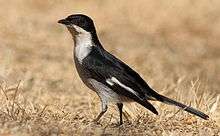Fiscal flycatcher
The fiscal flycatcher (Melaenornis silens) is a small passerine bird in the Old World flycatcher family. It is a resident breeder in Botswana, South Africa, Lesotho, Mozambique and Swaziland, and a vagrant to Namibia.
| Fiscal flycatcher | |
|---|---|
 | |
| Male | |
.jpg) | |
| Female | |
| Scientific classification | |
| Kingdom: | Animalia |
| Phylum: | Chordata |
| Class: | Aves |
| Order: | Passeriformes |
| Family: | Muscicapidae |
| Genus: | Melaenornis |
| Species: | M. silens |
| Binomial name | |
| Melaenornis silens (Shaw, 1809) | |
| Synonyms | |
|
Sigelus silens | |
This species is found in subtropical open woodland, dry savanna, shrubland and suburban gardens.
Taxonomy
The fiscal flycatcher was previously the only member of the genus Sigelus but was moved to Melaenornis based on the results of a molecular phylogenetic study published in 2010.[2][3]
Description
This black and white bird gets its name from its resemblance to the northern fiscal, a shrike.
The fiscal flycatcher is 17–20 cm in length. The adult male is black above and white below with white wing patches and white sides to the tail. The female is brown, not black, above. The juvenile is like the female but duller and with brown spots and scalloping above and below.
The song is a weak chittering, and the alarm call is tssisk.
The male can be confused with the northern fiscal, but the shrike has a heavy hooked bill, a white patch on the shoulder rather than the lower wing, and has no white on its longer tail.
The fiscal flycatcher is larger than the male collared flycatcher, which has a white collar and lacks white wing panels.
Behaviour
The fiscal flycatcher builds an open cup nest from thin stems and other plant material and lined with plant down. It is placed in a dense bush.
The fiscal flycatcher feeds on insects, often taken in flight.
References
- BirdLife International (2012). "Melaenornis silens". IUCN Red List of Threatened Species. 2012. Retrieved 26 November 2013.CS1 maint: ref=harv (link)
- Sangster, G.; Alström, P.; Forsmark, E.; Olsson, U. (2010). "Multi-locus phylogenetic analysis of Old World chats and flycatchers reveals extensive paraphyly at family, subfamily and genus level (Aves: Muscicapidae)". Molecular Phylogenetics and Evolution. 57 (1): 380–392. doi:10.1016/j.ympev.2010.07.008. PMID 20656044.
- Gill, Frank; Donsker, David (eds.). "Chats, Old World flycatchers". World Bird List Version 6.2. International Ornithologists' Union. Retrieved 20 May 2016.
Further reading
- Ian Sinclair, Phil Hockey and Warwick Tarboton, SASOL Birds of Southern Africa (Struik 2002) ISBN 1-86872-721-1
- del Hoyo, J.; Elliot, A. & Christie D. (editors). (2006). Handbook of the Birds of the World. Volume 11: Old World Flycatchers to Old World Warblers. Lynx Edicions. ISBN 84-96553-06-X.
External links
- Fiscal flycatcher - Species text in The Atlas of Southern African Birds.
